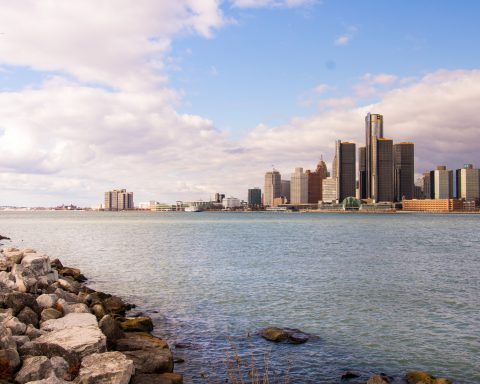
In my office, I have a print of a painting by the African American artist Horace Pippin, who is one of my heroes. The picture is titled “Holy Mountain III,” and it is one of three scenes Pippin painted that depict the promises found in Isaiah 65:17-25. In this picture, which is dated on the day the US bombed Nagasaki,[1] a black shepherd stands in a field with little children, snakes, lions, lambs, and all other manner of creatures who shall one day lie down together safely on God’s holy mountain. Camouflaged among trees in the background are images of falling bombs, lynched men, small white crosses, and other reminders of the horrors that humans can inflict upon one another. I keep this picture to remind me of Pippin’s courage, the resilience of his vocation, the faith he painted, and the hope he had for flourishing human community.
___________________________________________
Urban dwellers tend to lead highly segmented existences, characterized by membership in multiple communities. Coupled with the reality of geographic mobility, this presents a challenge to urban group life.
___________________________________________
I have that hope, too. I believe that as Christians we are called to proclaim our hope, as Pippen did through painting. I further believe that God intends us to use our vocations to pursue the visions found in this Isaiah text: to build healthy human communities that keep children safe, foster productive life for young and old alike, and – as the sixth great end of the church phrases it – exhibit the commonwealth of God to the world. This is God’s intention for us, and it begins locally with the invitation to build community in our churches, neighborhoods, and – as the US continues its trend toward urbanization—our cities.[2] But building healthy community in contemporary US cities can be a daunting challenge.

Sociologists have long recognized that the dynamics of urban life frustrate community formation. Writing in 1938, Louis Wirth observed that “Cities generally, and American cities in particular, comprise a motley of peoples and cultures, of highly differentiated modes of life between which there is often only the faintest communication, the greatest indifference and the broadest tolerance, occasionally bitter strife, but always the sharpest contrast.”[3] Wirth suggests that urban dwellers tend to lead highly segmented existences, characterized by membership in multiple communities. Coupled with the reality of geographic mobility, this presents a challenge to urban group life: “Partly as a result of the physical footlooseness of the population and partly as a result of their social mobility, the turnover in group membership generally is rapid…the task of holding organizations together and promoting intimate and lasting acquaintanceship between the members is difficult.”[4]
Any pastor or congregational leader who serves an urban population will likely affirm Wirth’s statement. Urban populations are transient; people come and go. Urban dwellers also tend to have multiple allegiances and commitments: they have one community at work, another at their kids’ school, another at their gym or other community gathering spot, another on their block or in their apartment complex, maybe another at their church. And the complexity of belonging has only gotten more complicated since Wirth wrote in the 1930s. Family structures have diversified. An increasing number of adults live alone, comprising nearly 40% of households in some US cities.[5] Social networking has reshaped and reformed what relationship looks like in our culture. Some people are growing more skittish about aligning with churches, defining themselves as “spiritual, not religious.”
___________________________________________
Humility and listening matter. We Presbyterians do not have all the answers to what makes cities, communities, and churches thrive; even if we did, we would not have the power needed to accomplish the fullness of that vision.
___________________________________________
It is hard work to build and sustain church community amid these realities. Not only does the simple fact of city living promote fragmentation, but the processes and structures that shape individuals’ lives are changing – sometimes faster than we can keep up with. If we want to be community builders in our cities, we need to understand better the challenges we face.

Place matters. In these days of social networking and virtual community-making, it seems counterintuitive or maybe just plain old fashioned to assert this, but nonetheless it is true: place matters. Churches and other kinds of community have contexts, and our institutions shape and are shaped by the places they inhabit. Robert J. Sampson, Patrick Sharkey, and other scholars affirm the enduring salience of place.[6] To a great extent, though not exclusively, we are the products of where we live, and so are our churches. I agree with Stephen Um and Justin Buzzard, who assert that good, effective urban ministry depends upon understanding and working within the contexts where we find ourselves.[7]
Networks and partnerships matter. Robert Sampson has discovered that human beings are more likely to thrive in communities characterized by what he calls “community efficacy.” These are communities in which civic organizations, block clubs, churches, and other institutions build networks of people and organizations; they build relationships, and those relationships promote community strength. As a friend of mine observed last summer, globalization may have changed the landscape that characterizes our cities, but relationships still matter. We need to forge them, inside and outside of our congregations, if we want neighborhoods and their inhabitants to thrive.
___________________________________________
[There is] plenty of ethical and theological reflection that focuses on particular issues, communities, or causes. But what [we] need more of is theology that gets past that sort of particularity.
___________________________________________
Humility and listening matter. We Presbyterians do not have all the answers to what makes cities, communities, and churches thrive; even if we did, we would not have the power needed to accomplish the fullness of that vision. We need to begin with humility and the recognition that others may have great ideas, too. So we should get to know the people around us, listen to them, and work with them to do whatever they say needs to be done. People like John McKnight and Peter Block have some great, workable ideas about how to do that.[8] Churches and religious leaders can benefit from putting some of these ideas into practice.

Theology matters. I imagine you have heard that sentence before, but it bears repeating. We need robust theological frameworks to support and guide the communities we form in our churches, neighborhoods, and cities. When I teach urban ministry at McCormick, as a sociologist I am able to find plenty of resources about how cities work, and as a minister I am able to dentify dozens of vibrant urban ministries that Presbyterians and other people of faith are conducting. I can also find plenty of ethical and theological reflection that focuses on particular issues, communities, or causes. But what I need more of is theology that gets past that sort of particularity. What I need more of is theology that helps students to build a strong ecclesiastical vision for today’s church. What I need more of is theology that is digestible, broad, and deep – theology that can help people wrestle with the very real challenges of building community in the city.[9] What is God’s vision for human flourishing? What convictions underlie the kinds of community we feel called to build and sustain in urban settings? What is the hope of the city for us and for all God’s people? The struggle to be the church in and for the city demands a theology that can inspire, guide, and sustain this work.
*****
AUTHOR BIO: Deborah Kapp is the Edward F. and Phyllis K. Campbell Associate Professor of Urban Ministry at McCormick Theological Seminary in Chicago. She is a sociologist with urban ministry experience in three congregations. Her current research involves photo elicitation interviews with women urban ministers.
To read other articles from Week 2: The Sin of your Sister Sodom, click here.
Read more articles in this series.
[1] This is a symbolic date; Pippen painted this picture later. The three paintings all have symbolic dates that recall the horrors of war: December 7, June 6, and August 9.
[2] In 2010 the US Census Bureau reported that 80% of the US population lives in urban areas, a slight increase from the previous decade. https://www.census.gov/newsroom/releases/archives/2010_census/cb12-50.html.
[3] Louis Wirth, “Urbanism as a Way of Life,” pp. 90-97 in The City Reader, Fourth Edition, edited by Richard T. LeGates and Frederic Stout. New York: Routledge 2007, p. 95.
[4] Ibid, p. 94.
[5] Eric Klinenberg, “One’s a Crowd.” The New York Times, February 4, 2012. http://www.nytimes.com/2012/02/05/opinion/sunday/living-alone-means-being-social.html?pagewanted=all&_r=0
[6] See Robert J. Sampson. Great American City: Chicago and the Enduring Neighborhood Effect. Chicago: University of Chicago Press 2012. Sampson examines neighborhoods characterized by concentrated inequality, in which disadvantage is multiplied, and he contrasts them to neighborhoods characterized by community efficacy, in which organizations band together to make a difference. See also Patrick Sharkey. Stuck in Place: Urban Neighborhoods and the End of Progress Toward Racial Equality. Chicago: University of Chicago Press 2013. Sharkey analyzes the generational transmission of poverty and inequality, and identifies factors that have contributed to that reality.
[7] Stephen Um and Justin Buzzard. Why Cities Matter: To God, the Culture, and the Church. Wheaton: Crossways Press 2013. See the chapters on contextualization for their ideas about how to analyze and understand place.
[8] I thank Bill Golderer of Broad Street Ministry in Philadelphia for recommending this book to me: Peter Block. Community: The Structure of Belonging. San Francisco: Berrett-Koehler Publishers, Inc. 2008. Block and McKnight have authored a new book, The Abundant Community: Awakening the Power of Families and Neighborhoods. San Francisco: Berrett-Koehler, 2010.
[9] Readers are free to contact me with suggestions. I’m always open to knowing about new resources and perspectives.






Unbound Social